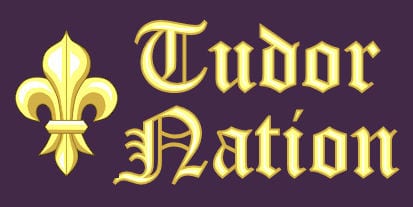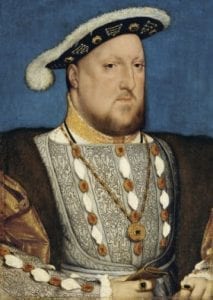A detailed chronology of the main events that happened in 1513 during the reign of King Henry VIII, showing dates, events and details
Events are coded:
Births, Baptisms, Marriages and Deaths
Trials, Imprisonments and Executions
Wars, Battles and Rebellions
Education, Art, Travel and Culture
Property and Possessions
Titles and Appointments
Acts of Parliament
Treaties and oaths
Church and Religion
Births, Baptisms, Marriages and Deaths
Trials, Imprisonments and Executions
Wars, Battles and Rebellions
Education, Art, Travel and Culture
Property and Possessions
Titles and Appointments
Acts of Parliament
Treaties and oaths
Church and Religion
during 1513
Lord Deputy of Ireland.
Gerald, 9th Earl of Kildare, became Lord Deputy of Ireland.
January 1513
War Preparations
Preparations for the invasion of France were well underway. The navy had been increased significantly and foreign ambassadors were becoming concerned about the strength of the Tudor navy.
February 1513
Thomas Wolsey Dean of York
Thomas Wolsey was appointed Dean of York.
March 1513
No Peace with Scotland
The English had suggested a new peace with Scotland to prevent any Scottish invasion while Henry was at war in France. However, the Scottish king stated that due to the Auld Alliance between Scotland and France he could not enter into any agreement with England.
25th March 1513
John Colet anti-war sermon
King Henry VIII attended a sermon preached by John Colet, Dean of St Paul’s Cathedral. Colet condemned ‘those Princes that preferred to follow Alexander the Great and Julius Caesar rather than following Jesus Christ in the promotion of peace.’ After the service Henry spoke to Colet stating that it was a bad idea to denounce war as evil when your king is about to invade France with the Pope’s blessing.
Spring 1513
Anne Boleyn sent to the Netherlands
Anne Boleyn was sent in the care of a knight named Broughton, to begin her service in the household of Margaret, Regent of the Netherlands.
1st April 1513
Treaty of Orthez
Henry’s ally and father-in-law, Ferdinand of Spain, secretly agreed a year-long truce with France. He used knowledge of Henry VIII’s upcoming invasion to secure a better deal for Spain.
5th April 1513
Treaty of Mechlin
This treaty was signed by the Pope, Holy Roman Emperor Maximillian, Ferdinand of Spain and Henry VIII of England. The terms bound them to declare war on France within the month.
18th April 1513
Anglo-Spanish Treaty
A treaty was signed in London by Ferdinand of Spain and Henry VIII. The Spanish agreed to invade Guienne in Henry’s name for a payment of 100,000 crowns. At the same time the English would begin an invasion of northern France.
20th April 1513
Naval blockade of Brest
Lord Admiral, Edward Howard, launched a mission to attack the French fleet at Brest. However, the French had anticipated such a move and had a fleet of ships equipped for inshore fighting waiting for the English. The English had to abandon the attack and blockade the port instead.
25th April 1513
Death of Edward Howard
Lord Admiral, Edward Howard decided to attack the French fleet at Brest a second time. He managed to grapple his ship with that of the French commander, Pregent de Bidoux, and boarded the French vessel. Unfortunately, the French ship broke free leaving Howard stranded. The French threw him overboard and he drowned due to the weight of his armour.
Late April 1513
Treaty of Mechlin
Ferdinand of Spain was forced to admit to his secret treaty with France and withdraw from this treaty.
May 1513
English Army to France
The English army began being transported to Calais.
4th May 1513
Thomas Howard Lord Admiral
Thomas Howard, brother of the late Edward Howard, was appointed Lord Admiral.
June 1513
Earl of Surrey sent north
Newly appointed Lord Admiral, Thomas Howard, Earl of Surrey, and his son, also Thomas, were sent north at the head of an army. They were tasked with guarding the northern border against any invasion by Scotland in support of France. Thomas Wolsey wanted to prevent Howard from going to France because he was concerned that Howard might be bent on revenge for his brother’s death and not follow battle orders.
13th June 1513
‘Great Harry’ Launched
Henry VIII’s latest ship the ‘Henry Grace A Dieu’, known as ‘Great Harry’, was launched at Erith on the River Thames.
15th June 1513
Henry VIII travelled to Dover
Henry and Catherine of Aragon rode out of London at the head of an army of 11,000 men bound for Dover. 14 richly decorated horses pulled carts laden with armour and plate while 14 wagons carried sections of a prefabricated house which would be the King’s residence in the field. At Dover castle, Catherine was formally invested with the regency of the country. Her advisors were to be William Warham, Archbishop of Canterbury, Thomas Ruthall and Richard Foxe.
mid June 1513
Siege of Therouanne
George Talbot, Earl of Shrewsbury and Charles Somerset, Lord Herbert, lay siege to Therouanne.
30th June 1513
Henry VIII travelled to Calais
Henry left England and sailed to Calais. On arrival he was escorted to the Church of St Nicholas to give thanks for a safe crossing.
21st July 1513
Henry VIII marched into France
After spending three weeks in Calais, Henry marched into France at the head of the English army.
25th July 1513
Scottish ships sent to relieve Therouanne
King James IV of Scotland sent a naval force to aid the French at the siege of Therouanne. The ships also carried a message for the English King warning that unless Henry VIII left French soil, he would invade England.
4th August 1513
War with France
Henry VIII reached the siege of Therouanne. The prefabricated buildings were erected to make a permanent camp outside the town. The Officers were housed in large coloured tents while the men slept in small plain tents. The English were soon joined by German troops led by Henry’s ally, Maximillian.
12th August 1513
War with Scotland
King James IV of Scotland declared war on England.
15th August 1513
Fighting between English and German Soldiers
Fighting broke out between English and German troops camped outside Therouanne. German soldiers seized artillery and turned it on the English while English archers fired at the Germans. Officers on both sides eventually managed to diffuse the situation but a number of men had lost their lives.
16th August 1513
Battle of the Spurs (Guinnesgate)
News of a French advanced reached the English stationed at Guinnesgate, south of Therouanne. As the 15,000 French force drew near, Henry gave the order to attack and the two armies met near the village of Borny. The English artillery broke French lines and then while the French were in disarray, the English cavalry charged. Seeing the approaching English cavalry, the French turned and fled with such speed that the battle was dubbed the Day of the Spurs. Many French noblemen were captured and held to ransom.
22nd August 1513
James IV invaded England
King James IV of Scotland crossed the border into England at the head of an army of 20,000 men.
24th August 1513
Therouanne Fell to the English
King Henry VIII and Maximillian, Holy Roman Emperor, triumphantly entered Therouanne after the garrison surrendered.
late August 1513
War with Scotland
The Scottish King took the castles of Norham, Wark, Etal and Ford. He chose Ford for his base. The owner of the castle, Sir William Heron was sent to Scotland as a prisoner.
late August 1513
War with France
Following success at Therouanne, Henry and Maximillian moved to Tournai.
Early September 1513
Catherine travelled north to direct the English army
Catherine of Aragon travelled north to be on hand if needed. She spoke to reserve forces camped urging them to be victorious.
7th September 1513
War with Scotland
The Scottish army was camped in a strongly fortified location on Flodden Edge. Queen Catherine ordered the Earl of Surrey to engage the Scottish in battle. Surrey was reluctant to take on such a large force so suggested single combat to James. The Scottish King declined the challenge.
8th September 1513
War with Scotland
The Earl of Surrey began a march to Berwick to take the town from the Scots.
9th September 1513
Battle of Flodden Field
On hearing of the English march to Berwick, the Scots had broken camp and moved to intercept the English. The Scottish army had reached the top of Branxton Hill when the English were sighted. James ordered his men to charge down the hill and take the English by surprise. However, a large number of Scots were killed by English arrows and cannon fire. As they ran down the hill the Scots had broken formation and were picked off by the English. Those that made it to the bottom of the hill were slaughtered. King James IV was among the 10,000 Scottish dead.
14th September 1513
Surrey’s Army Disbanded
King James IV had been succeeded by his infant son, James V. With a minor on the Scottish throne, Scotland no longer posed a threat to England and the army was disbanded.
15th September 1513
Siege of Tournai
The English army in France lay siege to Tournai.
17th September 1513
News of Flodden reached Henry VIII
A messenger arrived in the English camp bearing news of the English victory at Flodden. The messenger presented Henry with the blood-stained coat that James IV had been wearing when he died.
17th September 1513
Catherine premature birth
Catherine of Aragon went into labour prematurely. She was delivered of a son who died shortly after birth.
21st September 1513
Fall of Tournai
After several days of bombardment by English cannon, Tournai fell to the English.
17th October 1513
Treaty of Lille
With winter fast approaching, further hostilities in France were abandoned. This treaty was signed by Henry, Maximillian and Ferdinand. It bound them to make a combined invasion of France before June 1514. The treaty was to be sealed with the marriage of Ferdinand’s grandson, Charles, to Henry’s younger sister, Mary.
after 17th October 1513
Treaty of Lille
Thomas Wolsey was not happy with the terms of the treaty. In particular he felt that Henry’s sister, Mary could make a better marriage. Wolsey knew that the French King’s wife was ailing and felt that a match with France could bring favourable terms.
22nd October 1513
The English army came home
Ships were at work all day ferrying men home to England from Calais. There were celebrations to mark the return of the victorious English army.
Late October 1513
Wolsey made Bishop of Tournai
Thomas Wolsey was created Bishop of Tournai.
Published Mar 17, 2021 @ 3:10 pm – Updated –
Harvard Reference for this page:
Heather Y Wheeler. (2021 – 2024). Henry VIII Chronology – What Happened in 1513? Available: https://www.tudornation.com/henry-viii-chronology-1513 Last accessed [date]


